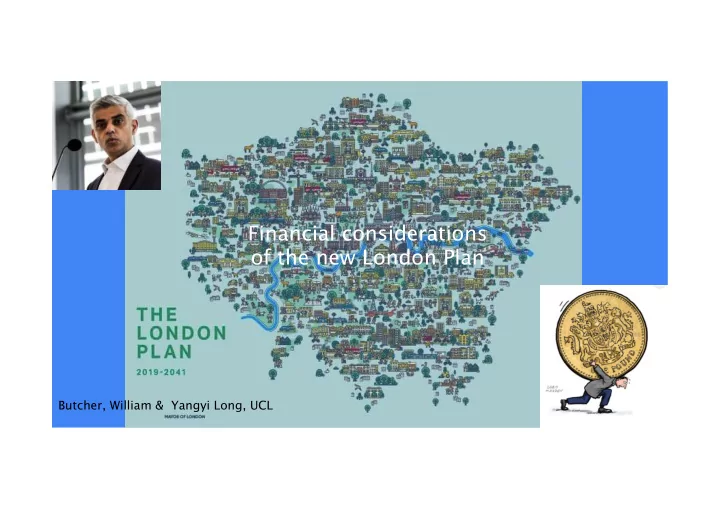

Financial considerations of the new London Plan Butcher, William & Yangyi Long, UCL
Current Plan ● Does not provide enough evidence how the funding gap will be met ● Timely delivery and optimised phasing are key for its success � ● Additional debt burdens associated with developments and infrastructure renewal across London (such as Vauxhall Nine Elms or Crossrail 2, etc) ● Heavily reliant on S106 and CIL as sources of income
Funding Gap: how can it be fulfilled? ● Huge funding gap: £3.1 billion per annum � ● Funds are currently mainly from public contributions � ● Areas of investment: housing, transport, green/social infrastructure, water, energy and digital connectivity � ● Need for more private investors � ● Explore other potential sources of funding
Transport ● Funded through a combination of sources (see 11.1.28 p.447). � ● Mega-infrastructure projects like HS2 or Crossrail 2 are the largest projects in terms of cost and time . ● TfL finances have long been in trouble… Mayor’s commitment to freeze fares and bus hopper ticket puts extra pressure. � ● Mayor should clarify how far his funding programmes will go towards meeting London’s housing need of 66,000 new homes a year, 65% of which are affordable.
Housing ● Delivery depends on the expansion in the range of delivery models used, and the tenures and types of homes delivered. � ● The Mayor has secured £3.15 billion to support 90,000 affordable housing, starting by 2021. � ● Initial estimates by GLA show that minimum £2.7 billion in public capital funding a year is needed for the housing need. ● Effective use of the land it owns and statutory powers if need be, and working with Mayoral Development Corporations, TfL, housing associations and developers are key for this delivery. � ● Reforms regarding compulsory purchase should be explored. The launching of a “Small Sites, Small Builders” programme, alongside changes to CIL and new planning policies will help as well.
Green Infrastructure ● Usually public authorities and various public or third-sector land-management bodies’ responsibility, however said that private sector actors (including utility companies, developers and businesses) are contributing to delivery. � ● Commitment to include natural capital accounts in the UK Environmental Accounts by 2020. � ● Public sector is the main funder, however future funding may be derived from a wider range of public sector sources . � ● New funding streams might include offsetting funds, new environmental levies to address specific challenges (such as surface water flooding), and new devolved mechanisms.
Social Infrastructure ● Investment raised locally, including from CIL & Section 106 contributions, and through public and private joint ventures . ● The Mayor will also explore other sources of investment such as philanthropic funding. ● Additional sources of funding will also be required, but will be difficult to access unless London is given greater control over its local tax base. � ● A specific fund for Primary care estate, the Estates and Technology Transformation Fund (ETTF) is in the second of a four-year programme (to 2020).
Other areas ● Regarding utilities, funds are raised mainly by providers through user charges . ● Mayor is working with providers and regulators to ensure the regulatory regime supports investment at the right time. ● London Infrastructure Plan estimates £8 billion required to provide the digital connectivity infrastructure London needs. ● Business will lead the transition to a circular economy (mix of venture capital and equity).
Next steps… ● Public participation in delivery needs to be significantly expanded. � ● On paper: “encourage active participation in the planning and delivery of development” however, are community voices being heard?? � ● Comments and feedback are crucial - need to be submitted to ensure Plan is sound and legally compliant. � ● Explore realistic alternative development scenarios.
Recommend
More recommend